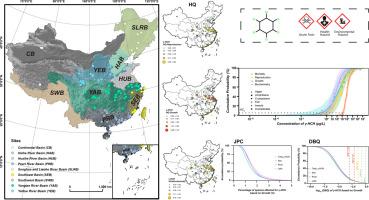中国地表水生态风险评估中六氯环己烷毒性阈值的推导
IF 12.4
1区 环境科学与生态学
Q1 ENGINEERING, ENVIRONMENTAL
引用次数: 0
摘要
虽然六氯环己烷(HCHs)在中国被长期禁用,但它们仍然普遍存在于地表水中,并对水生生物构成持续的威胁。我们检索了108篇已发表的文献,评估了它们在中国地表水(包括河流、湖泊和海洋)中的生态风险。大部分收集的数据测量的是可量化的HCHs,所有个体HCHs的检出率均超过85.0%。基于不同的毒性终点,构建了平均物种敏感性分布(SSD)模型,推导出HCHs的水质阈值。结果表明,α-六氯环己烷和β-六氯环己烷的死亡率预测无效应浓度(PNEC)分别为16.3和22.8 μg/L;提出了0.022 μg/L的PNEC作为γ-HCH的水生生物标准。一定比例的水生物种可能面临γ-HCH的不良生态效应,潜在影响比例为0.02% ~ 4.67%。分布商(DBQ)概率超过1/25的结果表明,湖泊中γ-HCH的暴露风险高于河流。潜在风险点主要分布在长江流域、黄河流域、珠江流域和淮河流域,属于传统农业区。本文章由计算机程序翻译,如有差异,请以英文原文为准。


Derivation of hexachlorocyclohexane toxicity thresholds for assessing ecological risks in the surface waters of China
Although hexachlorocyclohexane (HCHs) being prohibited for a long time in China, they still generally exist in the surface waters and pose a constant threat to aquatic organisms. We retrieved a total of 108 available published literature to assess their ecological risks in the surface waters of China, involving rivers, lakes, and seas. Most of the collected data measured quantifiable HCHs, with the detection rate exceeding 85.0 % for all individual HCHs. A model-averaging species sensitivity distribution (SSD) was constructed to derive the water-quality thresholds of HCHs based on various toxicity endpoints. The results showed that the mortality-based predict no-effect concentration (PNEC) was estimated to be 16.3 and 22.8 μg/L for α-HCH and β-HCH, respectively; The growth-based PNEC at 0.022 μg/L was proposed as the aquatic life criteria of γ-HCH. A certain percentage of aquatic species may face the adverse ecological effect of γ-HCH, with values of potential affected fraction ranging from 0.02 % to 4.76 %. The results of the probabilities of distribution-based quotient (DBQ) exceeding 1/25 showed that the risk of exposure to γ-HCH in the lakes was higher than those in the rivers and sea. The potential-risk sites were mainly located in Yangtze River Basin, Yellow River Basin, Pearl River Basin, and Huaihe River Basin, which belong to the traditional agricultural areas.
求助全文
通过发布文献求助,成功后即可免费获取论文全文。
去求助
来源期刊

Water Research
环境科学-工程:环境
CiteScore
20.80
自引率
9.40%
发文量
1307
审稿时长
38 days
期刊介绍:
Water Research, along with its open access companion journal Water Research X, serves as a platform for publishing original research papers covering various aspects of the science and technology related to the anthropogenic water cycle, water quality, and its management worldwide. The audience targeted by the journal comprises biologists, chemical engineers, chemists, civil engineers, environmental engineers, limnologists, and microbiologists. The scope of the journal include:
•Treatment processes for water and wastewaters (municipal, agricultural, industrial, and on-site treatment), including resource recovery and residuals management;
•Urban hydrology including sewer systems, stormwater management, and green infrastructure;
•Drinking water treatment and distribution;
•Potable and non-potable water reuse;
•Sanitation, public health, and risk assessment;
•Anaerobic digestion, solid and hazardous waste management, including source characterization and the effects and control of leachates and gaseous emissions;
•Contaminants (chemical, microbial, anthropogenic particles such as nanoparticles or microplastics) and related water quality sensing, monitoring, fate, and assessment;
•Anthropogenic impacts on inland, tidal, coastal and urban waters, focusing on surface and ground waters, and point and non-point sources of pollution;
•Environmental restoration, linked to surface water, groundwater and groundwater remediation;
•Analysis of the interfaces between sediments and water, and between water and atmosphere, focusing specifically on anthropogenic impacts;
•Mathematical modelling, systems analysis, machine learning, and beneficial use of big data related to the anthropogenic water cycle;
•Socio-economic, policy, and regulations studies.
 求助内容:
求助内容: 应助结果提醒方式:
应助结果提醒方式:


